- Faculty News
- Student News
- Lab News
- Publications
- Meetings and Presentations
- Outreach
- Grants
- Announcements
- About This Newsletter
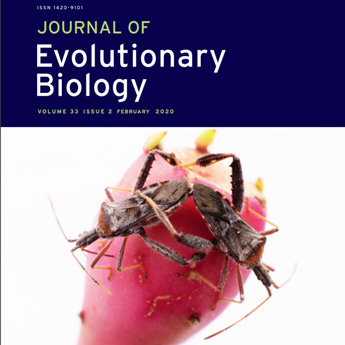
ABOVE: Journal of Evolutionary Biology cover photo! Narnia femorata, feeds from its local host plant, Opuntia mesacantha. Photo credit: Dr. Christine W Miller.
Dr. Norm Leppla was invited to visit Trulieve Cannabis’s 150,000 ft2 plant cultivation facility at Quincy, Florida. “It was amazing, and I was able to establish important connections for the UF/IFAS IPM Program. They have an experienced IPM manager who has established pest prevention practices, scouting methods with thresholds, and management methods based on a set of organic-type insecticides. The primary pest in their cannabis production system is the rice root aphid. The company has cannabis production facilities not only at Quincy but also Juniper Creek (Greensboro) and Clearwater, Florida. The facility at Quincy has about 700 employees. The cannabis plant canopy covers 4800 ft2 in each of two rooms. Visualize two Home Depot buildings full of cannabis plants, floor to ceiling! This doesn’t include large buildings where the plants mature and are harvested. Additionally, Trulieve is currently building a new facility at Montecello, Florida that is 9,500 ft2.”
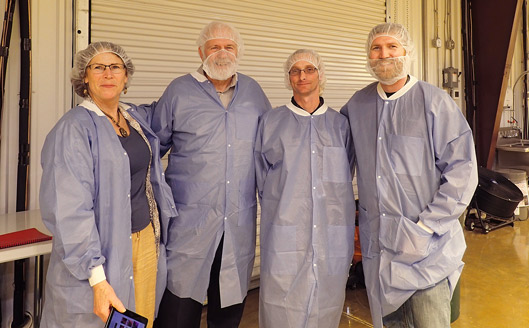
ABOVE: (Left to Right): Alison Kutz, President of Sound Horticulture, Bellingham, WA; Norm Leppla; Barry Ballard, Trulieve IPM Manager; and Donald Pake, Trulieve Production Manager.

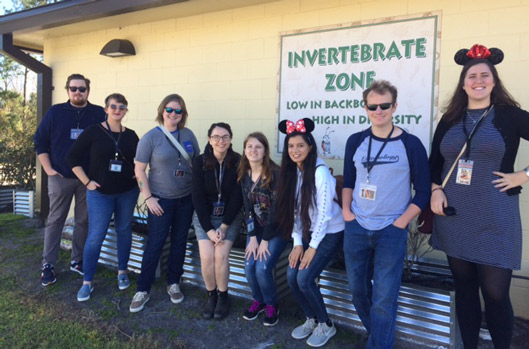
ABOVE: On January 25th, members of ENSO/DPMSO visited Disney's Animal Kingdom, where they got a behind-the-scenes tour of the invertebrate rearing facility. They had a great time and plan to arrange similar tours in the future!

On January 18th, Jessica Awad was invited to talk at the Center for Systematic Entomology annual meeting in Gainesville, FL. Her presentation was titled: "The Gall of It All: Exploring Synopeas Diversity in Papua New Guinea".
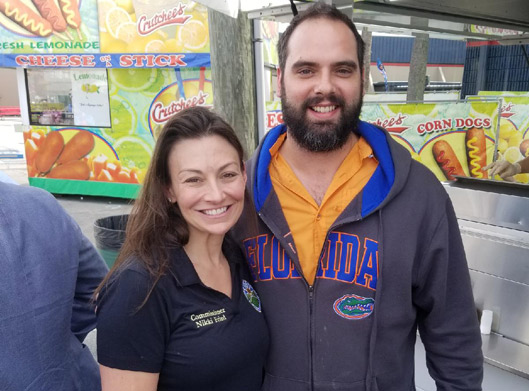
ABOVE: Clayton Bania, M.S. graduate student, stops for a photo with Nicole “Nikki” Fried, Florida’s 12th Commissioner of Agriculture and Consumer Services. Photo was taken on the 6th of February during the start of the Florida State Fair.
Need to name that bug? A host of experts are available to help Floridians identify any insect or related arthropod. If a mystery creature has six or more legs, the UF Insect ID Lab is the place to call.

ABOVE: The Peltotrupes profundus beetles are active again! This scarab beetle is only found in Florida, and inhabits areas of deep sand. Adults are active during the winter months. The female digs a deep vertical burrow that averages 6 feet deep, with a chamber at the bottom where the larva will live. We rarely see the beetles, just the fist-sized mounds that they leave behind.
If you need insect images for a publication or presentation for your UF/IFAS Extension or teaching work, you can go to this direct link, pictures are copyrighted material and intended for official UF use only. Log onto the website using your Gatorlink credentials.
Lyle Buss is the UF/IFAS Insect ID Lab manager.
 Think it might be a nematode problem? The Nematode Assay Laboratory serves Florida and other states by providing nematode assays and expert advice regarding nematode management.
Think it might be a nematode problem? The Nematode Assay Laboratory serves Florida and other states by providing nematode assays and expert advice regarding nematode management.
For more information on the Nematode Assay Laboratory, please contact the lab manager Dr. Billy Crow.
Frank JH. 2020. The identity of the adventive Gryllotalpa Latreille species (Orthoptera: Gryllotalpidae) in Hawaii, with illustration of male genitalia of G. orientalis Burmeister. Insecta Mundi 0747: 1-8. George J, Kanissery R, Ammar E.-D, Cabral I, Markle LT, Patt JM, Stelinski LL. 2020. Feeding behavior of Asian citrus psyllid [Diaphorina citri (Hemiptera: Liviidae)] nymphs and adults on common weeds occurring in cultivated citrus described using electrical penetration graph recordings. Insects. 11, 48; https://doi.org/10.3390/Insects11010048.
Goltz NC, Awad J, Moore MR, Talamas EJ. 2020. A fortuitous find: a unique haplotype of Ooencyrtus nezarae Ishii (Encyrtidae: Encyrtinae) discovered in Florida. Biodiversity Data Journal 8: e36440. https://doi.org/10.3897/BDJ.8.e36440.
Greenway EV, Cirino LA, Wilner D, Somjee U, Anagnostou M E, Hepple RT, & Miller CW (2020). Extreme variation in testes size in an insect is linked to recent mating activity. Journal of Evolutionary Biology. 33(2), 142-150 https://doi.org/10.1111/jeb.13574.
Hassani-Kakhki M, Karimi N, El Borai F, Killiny N, Hosseini M, Stelinski LL, Duncan L. 2020. Drought stress impairs communication between potato (Solanum tuberosum) and subterranean biological control agents. Annals of the Entomological Society of America. 113: 23-29.
Williams JL, Zhang YM, Lloyd MW, LaPolla JS, Schultz TR, Lucky A. 2020. Global domination by crazy ants: Phylogenomics reveals biogeographic history and invasive species relationships in the genus Nylanderia (Hymenoptera: Formicidae). Syst. Entomol. 1–15. https://doi.org/10.1111/syen.12423
 New on Featured Creatures:
New on Featured Creatures:
Fish nematode, Huffmanela spp Authors: Fauve Wilson and Jennifer L. Gillett-Kaufman
Do you have a favorite creature? Learn how to make it into a Featured Creatures!
Dr. Thomas Chouvenc gave a series of seminars in January to discuss about the most recent advances in termite control research: at the Mississippi Pest Control Association annual meeting in Natchez, MS on Jan 15th, at the Florida Pest Management Association annual meeting on Jan 22nd in Orlando, FL, and at the Certified Pest Control Operators of Florida field day on Jan 31st in Ft Lauderdale, FL.
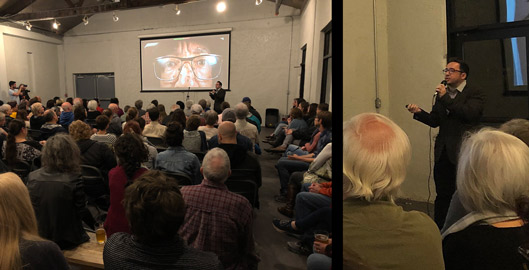
ABOVE: Dr. Lawrence Reeves gave a presentation on mosquitoes for the Florida Museum of Natural History and Thompson Earth Systems Institute Science on Tap series "Is Florida Trying to Kill Me?" at Cypress and Grove.
From the Outreach Coordinator
January Outreach Events:
Jan 8th: Rawling ES Science Day- Clayton Bania
Jan 9th: Santa Fe HS Career Day: Dr. Rebecca Baldwin, Brett Labella
Jan 16th: Norton ES STEM Night-Clayton Bania
Jan 17th: Gator Nights- Dr. Rebecca Baldwin, and the Entomology Club
Jan 21st: Marion County Homeschool Tour- Clayton Bania, Dr. Rebecca Baldwin
Jan 22nd: Strange Things Bugz do at the Villages- Remy Powell
Jan 24th: Shell ES Career Day- Clayton Bania
Jan 26th: 4-H Insectathon- Dr. Blair Seigfried, Dr. Rebecca Baldwin, Dr. Marc Branham, Wriley Gott, Brianna Whitman, David Plotkin, Clayton Bania, The Entomology club
Jan 27th: CPET Junior Science and Engineering Fair- Dr. Rebecca Baldwin, Clayton Bania, Remy Powell
Jan 31st: STEM Day Foster ES- Clayton Bania
The live critters are always a hit with children and adults alike. The critters are available for you to check out should you be leading an outreach event. We have doubles of our most popular critters, as well as various native insect species depending on the time of year. We have large wood and Plexiglas cages for viewing our native orb weaving spiders. There is one travel cage and one larger static cage. Please be sure to contact us and review the protocol on transporting and handling the critters if you are not already familiar with it. If you lead an outreach, be sure to fill out a documentation form so your event can be included in the newsletter and we can log all outreach events.
If you have any questions, please email me.
Thank you —Clayton Bania, Outreach Coordinator.
If you would like to schedule an event or have any outreach questions, go to the Outreach pages on our Bug Club website and contact us.
Getting social!
We have several social media sites for the Entomology & Nematology Department. To make them easily searchable, all three (YouTube, Facebook and Twitter) have the same page name: UFEntomology. Please share these links with past students or colleagues who may have an interest in departmental activities.
Suzy Rodriguez is the newsletter editor and does the HTML coding. Issues usually are published by mid-month. Submit items for an issue by the seventh of that month.
We like to share news when it happens using our social media outlets: Twitter, Facebook and YouTube. Follow us on these sites for daily updates! When you send news, we will post it on one or more of these sites and again in the monthly newsletter. Please be sure you have permission from people in photographs you submit for publication.
UF-Bugnews-L listserv subscribers receive notices when issues are posted. Our home page has instructions for subscribing and unsubscribing.
Special thanks to Eleanor Phillips and Nancy Sanders, and Glinda Burnett who reviewed the newsletter for errors, and to Jane Medley and Don Wasik, who built the web page design.
Give Back
Want to support the UF Entomology & Nematology Department? Consider making an online gift today! Questions can be directed to Christy Chiarelli at (352) 392-1975 or ccw@ufl.edu.